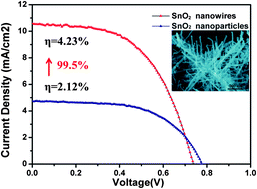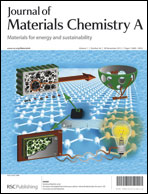In situ Au-catalyzed fabrication of branch-type SnO2 nanowires by a continuous gas-phase route for dye-sensitized solar cells†
Abstract
Branch-type SnO2 nanowires with high crystallinity have been successfully prepared by a rapid and continuous flame spray pyrolysis (FSP) route. The SnO2 branch has an average diameter of 15–20 nm and a length of 200–700 nm. As is known, this is the first time one dimensional SnO2 nanowires with branch-type nanostructures have been synthesized using flame synthesis. The average growth rate of nanowires could reach 1 μm s−1, which is thousand times faster than other methods. Interestingly, it is found that Au nanoclusters appear at the tip of SnO2 nanowires. An in situ Au-catalyzed vapour–liquid–solid (VLS) model is proposed to explain the growth mechanism of branch-type SnO2 nanowires in flame. As photoanodes, the DSSCs based on branch-type SnO2 nanowires (with TiCl4 post-treatment) show a higher short-circuit current (JSC = 10.60 mA cm−2) and a superior power conversion efficiency of 4.23%, improved by 99.5% compared to pure SnO2 nanoparticles (2.12%). The efficiency improvement could be attributed to the unique branch-type nanowire architecture, which provides a highly efficient electron channel and excellent ability of light scattering.


 Please wait while we load your content...
Please wait while we load your content...